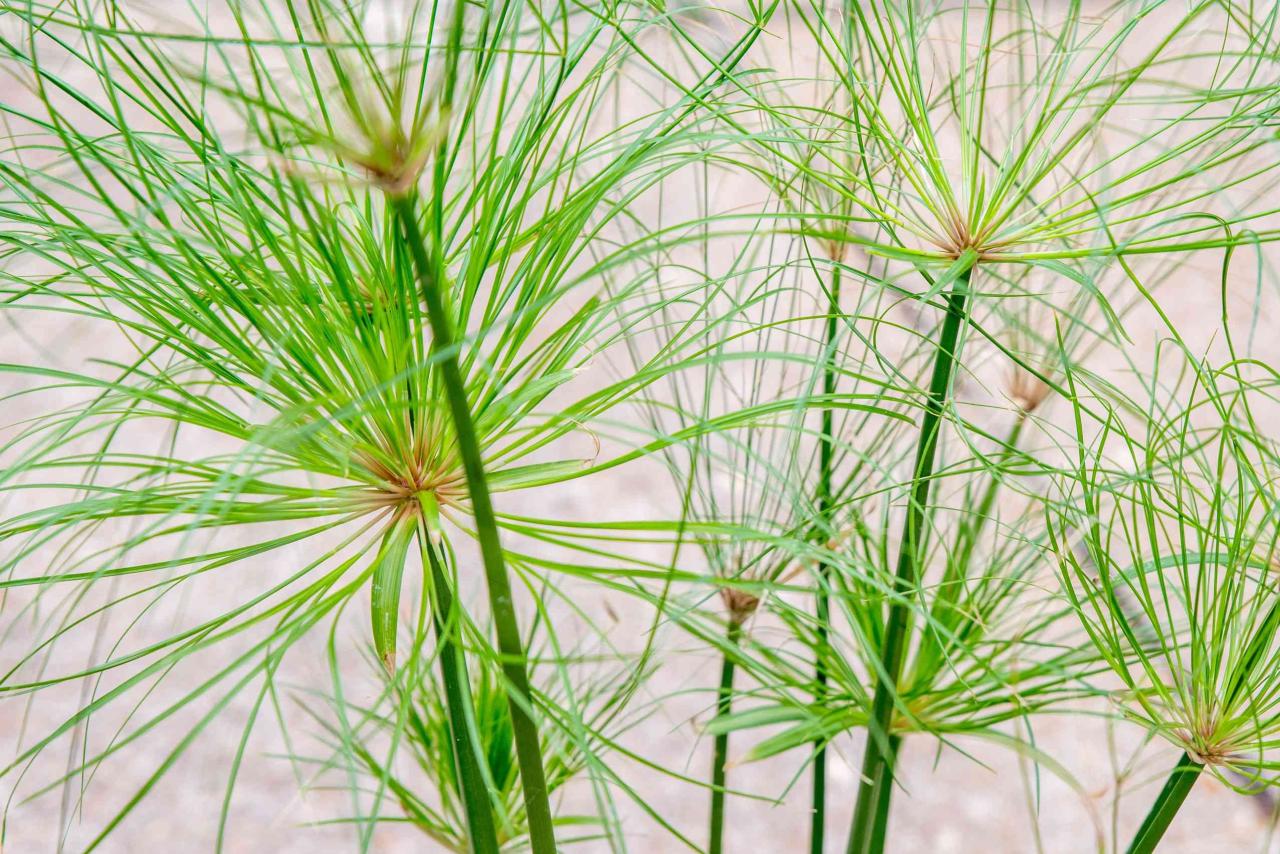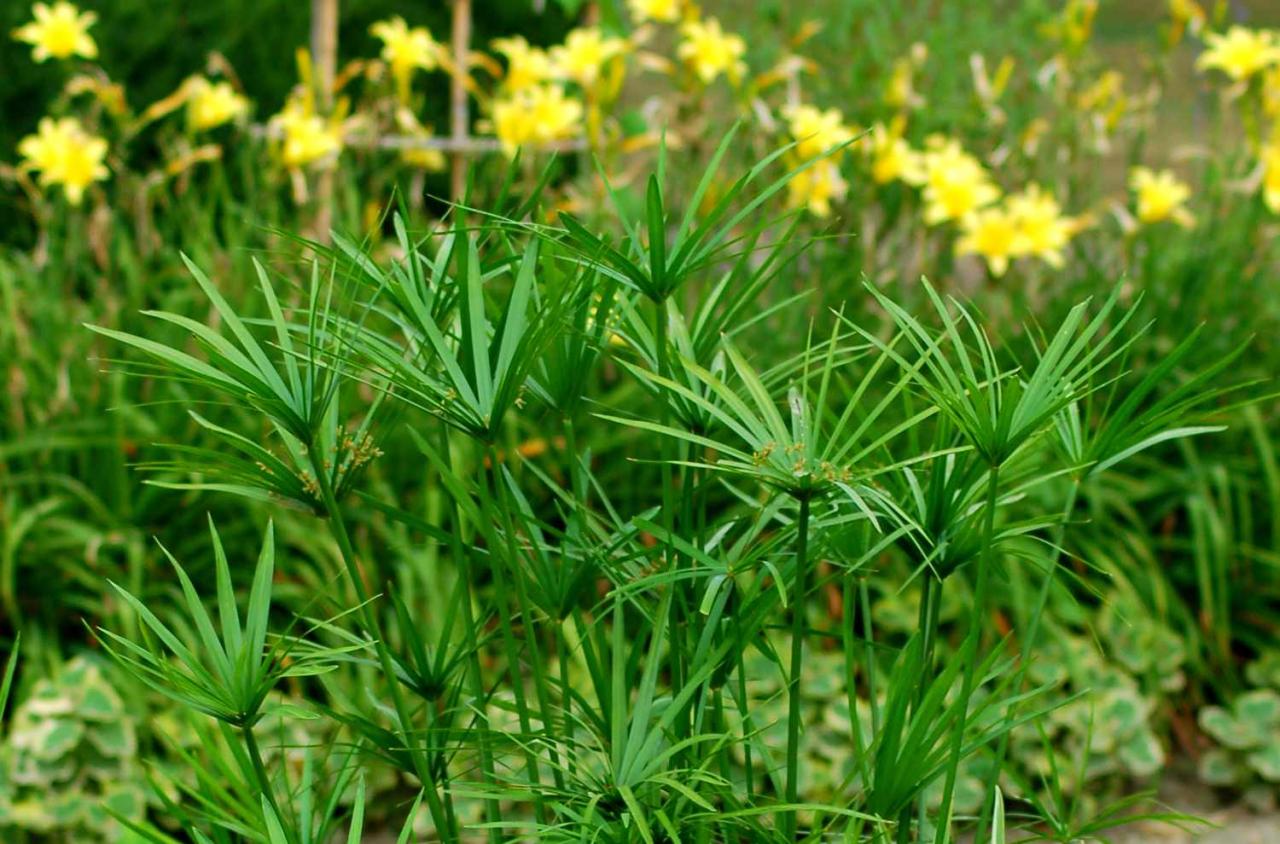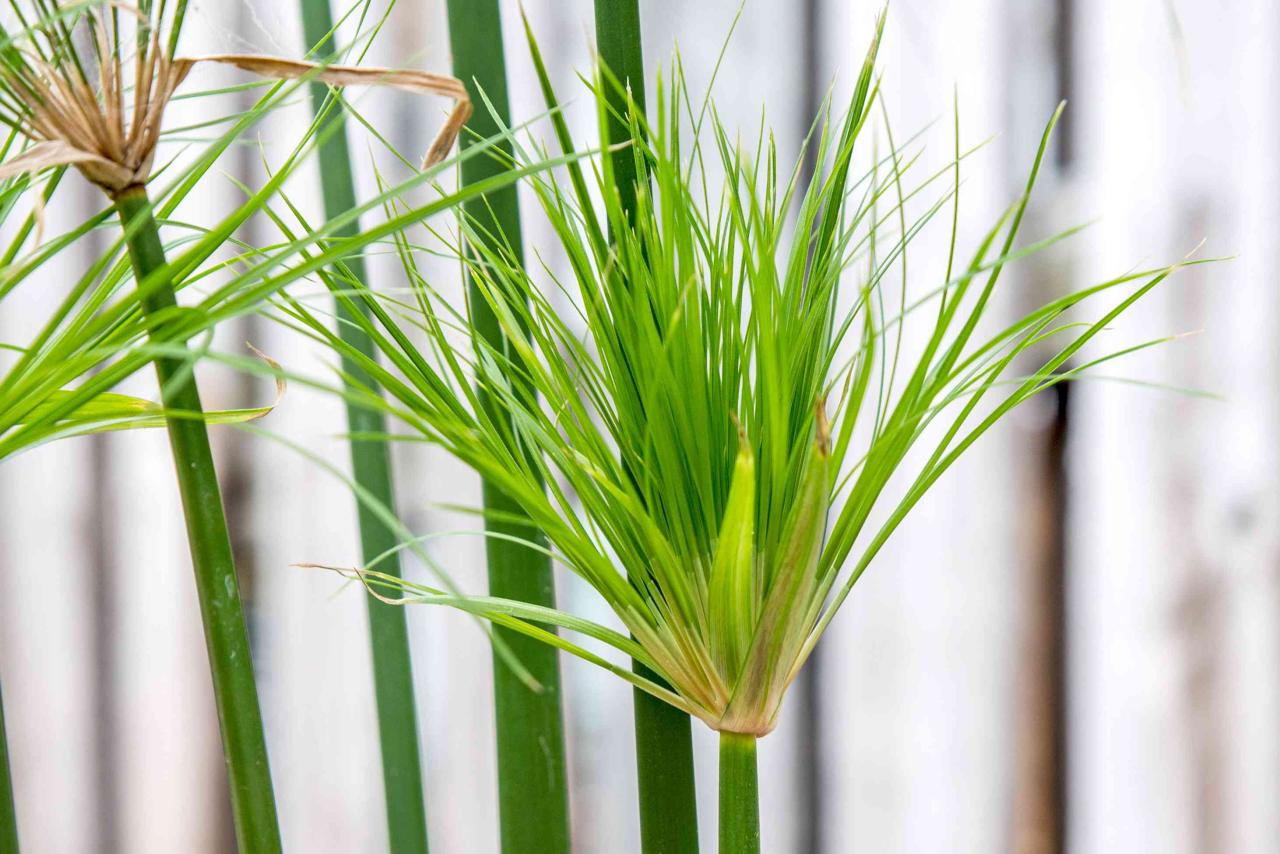How to Create a Stunning Garden Feature with Papyrus Plant: Essential Growing Tips – The papyrus plant, with its distinctive feathery plumes and historical significance, offers a unique and captivating addition to any garden. From its origins in ancient Egypt to its modern-day versatility, papyrus has captivated gardeners and designers alike.
This guide delves into the world of papyrus plants, exploring their characteristics, cultivation, and design possibilities, empowering you to create a breathtaking garden oasis.
This comprehensive guide explores the intricacies of cultivating papyrus plants, from selecting the right variety to ensuring optimal growing conditions. It also provides insightful tips on designing stunning garden features that showcase the unique beauty of these remarkable plants. Discover how papyrus can transform your garden into a captivating haven of tranquility and natural elegance.
Introduction to Papyrus Plants
Papyrus plants, scientifically known asCyperus papyrus*, are iconic aquatic plants that have played a significant role in human history and continue to captivate gardeners today. These unique plants offer a touch of ancient elegance and tropical charm to any water feature, making them a popular choice for both traditional and contemporary gardens.
Papyrus plants are native to the wetlands and riverbanks of Africa, particularly in the Nile River Valley. They thrive in warm, humid environments with ample sunlight and access to water.
Historical Significance of Papyrus Plants
Papyrus plants hold a rich history, deeply intertwined with the ancient civilizations of Egypt and other parts of the Mediterranean region. The ancient Egyptians, known for their advanced civilization, used papyrus plants for a wide range of purposes, including:
- Paper Production:Papyrus stems were processed into sheets, forming the primary writing material for ancient Egyptians. These sheets, known as “papyrus scrolls,” served as a medium for recording important documents, religious texts, and literary works.
- Building Materials:Papyrus stalks were used for constructing mats, baskets, and even boats. Their flexibility and durability made them valuable for various applications.
- Religious and Symbolic Significance:Papyrus plants held deep symbolic meaning in ancient Egyptian culture. They were associated with the god Osiris, representing life and rebirth.
Versatility of Papyrus Plants in Modern Garden Design
Papyrus plants have transitioned from their historical significance to become a sought-after element in modern garden design. Their striking appearance and adaptability make them a versatile choice for creating stunning water features and adding a touch of tropical allure to outdoor spaces.
- Water Gardens and Ponds:Papyrus plants thrive in water gardens and ponds, adding a touch of natural beauty and providing habitat for aquatic life. Their tall, feathery plumes create a dramatic focal point and provide shade for fish.
- Container Gardens:Papyrus plants can also be grown in large containers, adding a vertical element and tropical flair to patios, decks, and balconies.
- Tropical Gardens:Papyrus plants are a natural fit for tropical gardens, where their lush foliage and exotic appearance complement other tropical plants.
- Modern Landscapes:Papyrus plants can be incorporated into modern landscapes, creating a striking contrast against clean lines and minimalist design elements.
Choosing the Right Papyrus Variety
Choosing the right papyrus variety for your garden is crucial for ensuring its successful growth and achieving the desired aesthetic. With a wide range of papyrus species and cultivars available, it’s important to consider your specific garden space, climate, and desired features when making your selection.
Papyrus Variety Characteristics
The selection of a papyrus variety for your garden should be based on the specific characteristics of each variety, including size, color, and growth rate.
- Size:Papyrus varieties range in size from dwarf cultivars that reach a height of 3 feet to towering varieties that can grow up to 15 feet tall.
- Color:While most papyrus varieties have green foliage, some cultivars exhibit unique colors, such as variegated foliage with streaks of white or yellow.
- Growth Rate:Papyrus plants are known for their rapid growth, but the rate can vary depending on the variety. Some cultivars grow more quickly than others, requiring more frequent pruning and maintenance.
Papyrus Varieties for Different Garden Spaces
- Small Gardens:For smaller gardens, dwarf papyrus varieties such as Cyperus papyrus ‘Baby Tut’or Cyperus papyrus ‘Little King’are ideal. These cultivars maintain a compact size and can thrive in containers, making them suitable for patios, balconies, and smaller water features.
- Large Gardens:In larger gardens, taller varieties like Cyperus papyrus ‘King Tut’or Cyperus papyrus ‘Giant’can be used to create a dramatic focal point. Their towering presence adds a tropical touch to the landscape and can be used to screen or define different areas of the garden.
Papyrus Varieties for Different Climates
- Warm Climates:Papyrus plants thrive in warm climates with ample sunlight and humidity. Varieties like Cyperus papyrus ‘King Tut’and Cyperus papyrus ‘Giant’are well-suited for these conditions and can reach their full potential in tropical and subtropical regions.
- Cooler Climates:While papyrus plants are generally considered tropical, some varieties are more tolerant of cooler temperatures. Cyperus papyrus ‘Baby Tut’and Cyperus papyrus ‘Little King’can withstand mild winters and can be grown in USDA Hardiness Zones 8-10.
Advantages and Disadvantages of Papyrus Varieties
- Advantages:
- Fast Growth:Papyrus plants are known for their rapid growth, providing a quick and easy way to add vertical interest to the garden.
- Attractive Foliage:The distinctive foliage of papyrus plants creates a tropical and elegant aesthetic.
- Water-Loving:Papyrus plants thrive in wet conditions, making them ideal for water features, ponds, and bog gardens.
- Disadvantages:
- Maintenance:Papyrus plants require regular pruning to maintain their shape and prevent them from becoming too large.
- Invasive Potential:In some climates, papyrus plants can become invasive, spreading rapidly and outcompeting native plants.
- Pest and Disease Susceptibility:Papyrus plants can be susceptible to pests and diseases, particularly in humid conditions.
Essential Growing Conditions

Papyrus plants thrive in specific conditions that mimic their natural habitat. Understanding these conditions is crucial for ensuring healthy growth and a stunning display in your garden.
Soil Requirements
Papyrus plants prefer rich, moist soil that is well-drained. The ideal soil pH for papyrus plants is slightly acidic to neutral, ranging from 6.0 to 7.0. Poor drainage can lead to root rot, which can be fatal to the plant.
To improve drainage, you can amend the soil with compost, peat moss, or sand.
Light Requirements
Papyrus plants need plenty of sunlight to flourish. They prefer a location that receives at least six hours of direct sunlight daily. However, they can tolerate some shade, especially in hot climates. In areas with intense afternoon sun, it is best to provide some shade during the hottest part of the day to prevent scorching.
Temperature Preferences
Papyrus plants are tropical plants and are sensitive to frost. They thrive in warm temperatures and can tolerate heat well. The ideal temperature range for papyrus plants is between 65°F and 85°F (18°C to 29°C). In colder climates, papyrus plants can be grown indoors or in a greenhouse during the winter months.
Planting and Propagation
Planting papyrus in your garden is a rewarding experience, adding a touch of exotic beauty to your landscape. The process is relatively straightforward, but understanding the best practices ensures a healthy and thriving papyrus plant.
Planting Papyrus in the Garden
Planting papyrus is best done during the spring or early summer when the soil has warmed up. This allows the plant to establish itself before the colder months. Here are the steps for planting papyrus:
- Choose a suitable location:Papyrus thrives in full sun to partial shade, but it needs ample moisture. Select a spot that receives at least 6 hours of sunlight daily and has well-drained soil.
- Prepare the planting hole:Dig a hole twice as wide and as deep as the root ball of the papyrus plant.
- Amend the soil:Papyrus prefers slightly acidic soil with a pH of 6.0 to 7.0. If your soil is alkaline, you can amend it with peat moss or sulfur.
- Place the papyrus plant:Gently remove the plant from its container and loosen any roots that are circling. Place the plant in the hole, ensuring the top of the root ball is level with the ground.
- Backfill the hole:Fill the hole with soil, gently pressing it down around the plant to remove air pockets.
- Water thoroughly:After planting, water the papyrus plant deeply to settle the soil and encourage root growth.
Propagation Methods
Papyrus plants can be propagated using two primary methods: division and seed sowing.
- Division:This method is the most common and easiest way to propagate papyrus. It involves separating a clump of the plant into smaller divisions.
- During spring or early summer, gently dig around the base of the papyrus plant.
- Carefully separate a section of the plant, ensuring each division has healthy roots and foliage.
- Plant the divisions in a new location, following the same steps as planting a new papyrus plant.
- Seed Sowing:Papyrus seeds can be sown directly into the garden or started indoors.
- Sow seeds in a seed tray filled with a well-draining seed-starting mix.
- Keep the seeds moist and warm, and they should germinate within a few weeks.
- Once the seedlings have a few sets of true leaves, they can be transplanted outdoors.
Choosing the Right Planting Time and Spacing
- Planting Time:The best time to plant papyrus is during the spring or early summer, after the last frost. This allows the plant to establish itself before the colder months.
- Spacing:Papyrus plants need space to grow. When planting, space them 2 to 3 feet apart.
Care and Maintenance

Papyrus plants, while relatively easy to grow, require consistent care to thrive. Providing the right amount of water, nutrients, and protection from pests and diseases is crucial for maintaining their vibrant health and stunning appearance. This section delves into the essential care practices for papyrus plants.
Watering Needs
Papyrus plants are water-loving, thriving in moist environments. Consistent watering is crucial for their growth and development. The frequency and depth of watering depend on factors like climate, pot size, and soil type.
Papyrus plants, with their tall, feathery plumes, can create a dramatic focal point in any garden. While their architectural presence is striking year-round, they truly shine in autumn when their foliage takes on warm hues. If you’re looking for ways to add a touch of autumnal charm to your home, consider creating a stunning leaf garland using the vibrant colors of your papyrus plant.
For inspiration, check out How to Make an Eye-Catching Autumn Leaf Garland: Tips and Tricks for Success for detailed instructions and creative ideas. Once you’ve incorporated your papyrus plant’s autumnal beauty into your home decor, you can return to your garden and admire the plant’s graceful presence throughout the colder months.
- Frequency:Water the papyrus plant deeply when the top inch of soil feels dry to the touch. This usually translates to watering 2-3 times a week during the growing season (spring and summer) and once a week during the dormant season (fall and winter).
- Depth:Water thoroughly, ensuring the water drains through the drainage holes at the bottom of the pot. This allows the roots to access the water and prevents the soil from becoming waterlogged.
Fertilizing
Regular fertilization is essential for papyrus plants to maintain their vibrant growth and lush foliage.
- Frequency:Fertilize every 2-4 weeks during the growing season (spring and summer) with a balanced liquid fertilizer diluted to half strength. Avoid fertilizing during the dormant season (fall and winter) as the plant’s growth slows down.
- Types of Fertilizer:Use a balanced liquid fertilizer with an NPK ratio of 10-10-10 or 20-20-20. Organic fertilizers like compost tea or fish emulsion can also be used.
Pests and Diseases
While generally resistant to pests and diseases, papyrus plants can be susceptible to certain issues.
- Common Pests:Mealybugs, aphids, and spider mites are common pests that can affect papyrus plants. These pests can be controlled by using insecticidal soap or neem oil spray. Regularly inspect the plants for signs of infestation, such as white, cottony masses (mealybugs), tiny, soft-bodied insects (aphids), or fine webbing (spider mites).
Papyrus plants, with their striking architectural form, add a touch of the exotic to any garden. These tall, graceful plants thrive in moist conditions and can be used to create a stunning focal point or a lush backdrop for other plants.
While you’re focusing on your garden’s visual appeal, don’t forget about adding some exotic flair to your meals! How to Add Kaffir Lime Leaf to Your Meals: A Guide to Unique and Flavorful Dishes will guide you through incorporating this fragrant ingredient into your dishes.
Once you’ve mastered the art of adding kaffir lime leaf, you’ll be ready to enjoy a garden that delights both the eye and the palate!
- Common Diseases:Root rot and leaf spot are common diseases that can affect papyrus plants. Root rot occurs when the soil is waterlogged, leading to root damage and plant decline. Leaf spot is a fungal disease that causes brown or black spots on the leaves.
These diseases can be prevented by ensuring proper drainage and avoiding overwatering.
Designing a Stunning Garden Feature

Papyrus plants, with their striking vertical forms and lush foliage, offer a unique opportunity to create captivating garden features. Their versatility allows them to be incorporated into various design styles, from tranquil water gardens to bold contemporary landscapes.
Garden Feature Examples
- Imagine a serene pond with a small island in the center, adorned with a cluster of papyrus plants. The towering stems, reaching towards the sky, create a sense of tranquility and seclusion. The vibrant green foliage contrasts beautifully with the calm water surface, reflecting the surrounding greenery and the azure sky.
- In a contemporary garden, a striking feature could be a minimalist water feature with a cascading waterfall. Papyrus plants, planted in large containers, flank the water feature, adding a touch of tropical elegance. The contrast between the smooth, modern lines of the water feature and the textured foliage of the papyrus plants creates a visually stimulating juxtaposition.
Ways to Use Papyrus Plants in Garden Features
Garden Feature |
Papyrus Plant Use |
|---|---|
Ponds and Water Gardens |
Planted at the edge of ponds or in shallow water, creating a natural, tropical feel. |
Borders |
Used as a focal point or to create a vertical accent in mixed borders, adding height and texture. |
Containers |
Planted in large pots or planters, adding a tropical touch to patios, decks, and balconies. |
Combining Papyrus Plants with Other Plants and Materials
To create a harmonious and visually appealing design, consider combining papyrus plants with other plants and materials that complement their texture and form.
- Water Features:Papyrus plants pair well with water lilies, lotus flowers, and other aquatic plants. Their towering stems create a contrasting backdrop for the delicate blooms of these water-loving plants.
- Borders:Combine papyrus plants with grasses, ferns, and other plants with similar textures and colors. This creates a sense of unity and visual interest.
- Containers:Pair papyrus plants with colorful annuals or perennials in contrasting colors. This adds a vibrant splash of color to your container garden.
- Materials:Use natural materials like stone, wood, and gravel to complement the natural beauty of papyrus plants. This creates a cohesive and inviting design.
Benefits of Papyrus Plants
Papyrus plants offer a multitude of benefits, enriching both the aesthetics and ecology of your garden. Beyond their striking visual appeal, they play a crucial role in promoting biodiversity and improving the overall health of your ecosystem.
Enhancing Garden Aesthetics, How to Create a Stunning Garden Feature with Papyrus Plant: Essential Growing Tips
Papyrus plants are a visually captivating addition to any garden, adding a touch of tropical elegance with their tall, feathery plumes. Their unique texture and graceful form create a sense of tranquility and sophistication, making them ideal for creating focal points or adding vertical interest to your landscape.
Their vibrant green foliage provides a refreshing contrast against other plants, adding depth and dimension to your garden design.
Supporting Biodiversity and Wildlife
Papyrus plants create a haven for a variety of wildlife, providing essential shelter, nesting sites, and food sources. Their dense foliage offers protection for small mammals, reptiles, and amphibians, while their seeds and stems provide sustenance for birds and other creatures.
The presence of papyrus plants contributes to the overall biodiversity of your garden, fostering a healthy and thriving ecosystem.
Reducing Erosion and Improving Water Quality
Papyrus plants are highly effective in reducing erosion along water bodies. Their extensive root systems stabilize the soil, preventing it from being washed away by wind and rain. This helps to maintain the integrity of your garden’s landscape and protect valuable water resources.
Furthermore, papyrus plants act as natural filters, absorbing excess nutrients and pollutants from the water, contributing to improved water quality and a healthier aquatic environment.
Wrap-Up
By embracing the captivating allure of papyrus plants, you can unlock a world of design possibilities, creating a garden that is both visually stunning and ecologically beneficial. From serene water gardens to vibrant borders, papyrus plants offer a touch of ancient charm and modern elegance.
So, let the graceful plumes of papyrus dance in your garden, adding a touch of the extraordinary to your outdoor space.
Clarifying Questions: How To Create A Stunning Garden Feature With Papyrus Plant: Essential Growing Tips
Can I grow papyrus plants indoors?
Yes, papyrus plants can be grown indoors, but they require bright, indirect light and consistently moist soil. They may also need a humidifier to maintain humidity levels.
What are the best companion plants for papyrus?
Papyrus plants pair well with other water-loving plants, such as water lilies, lotus, and cattails. They also complement tropical plants, grasses, and ferns.
Are papyrus plants invasive?
Papyrus plants can be invasive in some climates, especially in warm, humid regions. It’s essential to choose the right variety and monitor their growth to prevent them from spreading uncontrollably.
